Title of the work
Country of the First Edition
Country/countries of popularity
Original Language
First Edition Date
First Edition Details
Száva István, A szirakuzai óriás. Budapest: Móra Ferenc Könyvkiadó, 1959, 333 pp.
ISBN
Genre
Historical fiction
Target Audience
Crossover (children, teenagers, young adults)
Cover
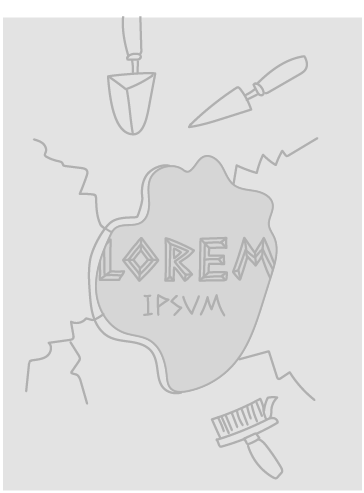
We are still trying to obtain permission for posting the original cover.
Author of the Entry:
Marta Pszczolińska, University of Warsaw, m.pszczolinska@al.uw.edu.pl
Peer-reviewer of the Entry:
Katarzyna Marciniak, University of Warsaw, kamar@al.uw.edu.pl
Elżbieta Olechowska, University of Warsaw, elzbieta.olechowska@gmail.com
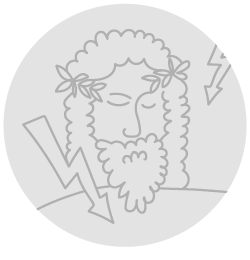
István Száva
, 1929 - 1970
(Author)
István Száva (until 1929, István József Schüller) was born in Budapest, then, part of Austria-Hungary, in a worker’s family. Despite his family’s lack of funds, he was encouraged to study. He enrolled in the humanities program at the Royal Hungarian Pázmány Péter University in Budapest. In 1926, he wrote his first novel Utcasarkok [Street Corners]. In 1927, he joined the Hungarian Social Democratic Party (Magyarországi Szociáldemokrata Pártba). In 1929, he was expelled from the university for leftist activities, and in 1935, he was jailed for promoting social hate. From 1944, he took part in the resistance movement organized by the Magyar Front. In 1945, he was elected as a deputy to the Hungarian National Assembly and, in 1947, to the parliament. That same year, he graduated with a degree in Hungarian, French and German. He led the Népszava [People’s Voice] newspaper from 1945, then became the editor-in-chief of the Kossuth Népe [Kossuth People] (1947–1948) and Szabad Nép [Free People] (1948) as a member of the MDP (Magyar Dolgozók Pártja [Hungarian Working People’s Party]). In 1950, he was arrested under false charges (war crimes, treason, anti-state organization) and sentenced to fifteen years in prison in a trial named after him: the Trial of István Száva and the others. During a retrial in 1956, he was rehabilitated by the Supreme Court. He worked as a teacher, translator (mostly Russian and French), and journalist (editor-in-chief of Hétfői Hírek [Monday News]). He is also known as the author of many novels.
His novelist activity produced mostly biographies of prominent historical figures, often connected to the natural sciences (Archimedes – A szirakuzai óriás [The Giant of Syracuse] published in 1959, Charles Darwin – Tengereken és évmilliókon át [Through the Seas and Millions of Years], 1961, Galileo Galilei – A hiúz a napba néz [The Lynx Looks at the Sun], 1962, Thomas Alva Edison – A Menlo-parki varázsló [The Menlo Park Wizard], 1963, Ignac Semmelweis – Egyedül a halál ellen [Against Death Alone], 1963, Johannes Kepler – Az ég törvénye [The Law of Heaven], 1965, Farkas and Janos Bolyai – Apa és fia [Father and Son], 1967, Pericles – Az istennő kegyeltje [Grace of the Goddess], 1969, Ferenc Rakoczi – A nagyságos fejedelem [The Great Prince], 1971), but also contemporary novels, mainly about the Near and Middle East. His books were translated into various languages, and their popularity continues – about half of his novels were published in recent years as e-books.
Sources:
Digitális História Adatbázis – Száva István available at TortenelmiTar.hu. (accessed: June 17, 2022);
Száva István in Magyar életrajzi lexikon at Arcanum.com (accessed: June 17, 2022);
Wikipedia (accessed: June 17, 2022).
Bio prepared by Marta Pszczolińska, University of Warsaw, m.pszczolinska@al.uw.edu.pl

Tamás Szecskó
, 1925 - 1987
(Illustrator)
Szecskó Tamás (1925–1987), a Hungarian graphic designer, illustrator and painter, was born in Budapest, where he later studied art history and drawing at the Hungarian University of Fine Arts MKE (Magyar Képzőművészeti Egyetem) under the direction of Róbert Berény, a famous Hungarian painter, one of the avant-garde group A Nyolcak [The Eight]. The young student’s drawings were first published when he was 15. He later worked for the journal Új Idők [New Times], drew advertising graphics and made slide films. He started as an illustrator in Singer and Wolfner Publishing House and later illustrated many books for Móra Könyvkiadó and Tankönyvkiadó Vállalat publishers, including textbooks. His drawing style was mainly expressed by black and white ink lines, but there were coloured illustrations as well. He illustrated books for Hungarian and foreign writers, including Lewis Carrol, Jules Verne, Arkady Gaidar, Carlo Collodi and Karl May. Altogether, his oeuvre includes about 500 books illustrated during his life. As a slide illustrator he drew Csipkerózsika [Sleeping Beauty] and Moby Dick a fehér bálna [Moby Dick the White Whale]. He also nurtured, in his son, an interest in graphic work, Péter Szecskó, who became an illustrator, graphic artist and painter, precisely like his father.
Source:
Wikipedia (accessed: June 17, 2022),
Goodreaders (accessed: June 17, 2022),
ieas-szeged.hu (accessed: June 17, 2022).
Bio prepared by Marta Pszczolińska, University of Warsaw, m.pszczolinska@al.uw.edu.pl
Adaptations
A slideshow for children – a roll of 60 coloured slides available at diafilm.osaarchivum.org:
A szirakuzai óriás, text: Száva István, drawings: Hollós Endre, editor: Ják Sándor, published by MDV, 1963. (accessed: June 17, 2022).
Translation
German: Der Gigant von Syrakus. Ein Archimedes-Roman, trans. Heinrich Weißling, ill. Tamás Szecskó, Budapest: Corvina, Leipzig: Prisma-Verlag, 1960, 415 pp.
Bulgarian: 1962.
Slovak: Obor zo Syrakúz, trans. Šarlota Barániková, Bratislava: Mladé letá, 1964, 296 pp.
Polish: Olbrzym z Syrakuz, trans. Camilla Mondral, ill. Romuald Klaybor, Warszawa: Nasza Księgarnia, 1966, 394 pp.
Ukrainian: Сіракузький велетень [Sirakuz’kyĭ veleten’], trans. Кonstantyn Bibikov, ill. Tamás Szecskó, Kyiv: Vydavnyt͡stvo Dyti͡achoi Literatury „Veselka”, 1971, 188 pp.
Summary
The entry is based on the Polish edition Olbrzym z Syrakuz, Warszawa: Nasza Księgarnia, 1966.
A Sicilian Greek boy, Sporos, plays with his friend Zeuxippos*. Sporos, son of the mathematician and astronomer Phidias**. Out of curiosity, he uses a bifurcated branch to draw circles on sand to see how many of them could be placed on the circumference of the central one; he discovers that the correlation ratio is not dependent on the size of the circles. His friend wants to go home, so he destroys the drawings; consequently, they argue and fight. Sporos’ father and his guest, having heard what had happened, admire the boy’s cleverness and start to call him Archimedes – “master of rigorous reasoning”. The boy indeed is of such a great mind and ingenuity that he astonishes both his peers and the adults. He grows up and figures out how to measure the sun elevation angle using a simple device made according to his design by a local carpenter.
When his father dies, Archimedes throws himself into study and work. On the demand of Hiero II of Syracuse, his kinsman***, he participates in rebuilding a theatre in the Neapolis district of Syracuse, placing some useful new scenic devices to heighten the performance of Aeschylus’ tragedy, Women of Aetna. As the opening night is a great success, Hiero asks the genius builder to his row and orders him to do something nobody else could complete: having suspicions about his goldsmith, he asks Archimedes to ascertain whether his new votive crown is made of pure gold. The idea of how to solve the problem of measuring an object’s density comes to Archimedes while in a bathtub, so the absent-minded inventor, out of joy, runs out of the house naked, shouting heúrēka! – “I have found”****.
Having solved the problem, Archimedes embarks on a journey to Alexandria,***** where he stays for three years. The possibility of being in touch and exchanging ideas with the most eminent academics of that time makes him excited and happy. Eratosthenes, called Beta, the headmaster of the Library, introduces the Syracusan scholar to people frequenting the Mouseion. Later on, they cooperate in calculating the circumference of the Earth. Despite the academic work, Archimedes is much appreciated for what he calls “just a mechanic toy” – Archimedes’ screw, facilitating Egyptian farmers to water their fields******.
Archimedes returns to Sicily. As a result of a bet with Hiero, he constructs a machine which lets him pull an entire ship with its crew and cargo. Hiero, amazed by the show, asks Archimedes to build some defensive and offensive war machines. An ongoing war between Rome and Karthago places Syracuse, the key to Sicily and the sea, in a difficult position. Archimedes designs and supervises the construction of equipment for the royal ship – a combination of excessive luxury and warfare. While building and equipping the ship, he continues research on the sphere and cylinder and figures out how to count grains of sand using the myriad myriad concept.
The Second Punic war begins after years of peace. Hiero II gets older but is still of sound mind. As a wise and far-sighted man, he appreciates peace but asks Archimedes to again prepare some plans for a war machine as possible salvation if the situation starts turning for the worse. Unfortunately, Hiero dies, and his grandson Hieronymus becomes the new tyrant at 15. In contrast to his grandfather’s greatness, the boy is spoiled and only uses his power and wealth to pursue pleasure. He abuses wine and eventually leads Syracuse to doom as he breaks the alliance with Rome; he offends Roman deputies and members of the legation. His lack of political foresight and his contempt for state duties results in a plot for his murder. The Syracusans are divided; pro-Roman and pro-Punic factions start to fight in a civil war. Supporters of pro-Punic politics win; Syracuse becomes an ally of Karthago and incurs the ire of Rome.
M. Cl. Marcellus leads the Roman invasion of Sicily. He conquers Leontinoi and targets Syracuse as next. Although Archimedes is a pacifist regarding the siege, he decides to prepare the defence of his home city to protect his right to scholarly work. Using catapults, which he refers to as “mechanical toys”, and other war machines, including new inventions, such as the claw “ship-snatcher” and the blinding mirrors, he bolsters the defence and gives Syracusans new hope. Each Roman assault fails. After eight months of siege, the city walls are untouched while Roman morale is so low that the army panics at the sight of lath and rope on the walls, afraid that it is a new Archimedes’ device. The Romans retreat, the citizens celebrate, and people lower their guard. At night, the Romans come back and conquer district after district. At dawn, in Archimedes’ garden, a Roman soldier sees an older man drawing geometrical calculations on the sand. Thinking it might be Archimedes and, considering him a dangerous warlock, he wants to protect Rome by destroying the drawings. As Archimedes asks him not to disturb his circles and continues his calculations, the soldier interrupts what he thinks are incantations to evil powers and stabs him. As an epitaph, Marcellus orders a sphere and cylinder be placed on Archimedes’ tomb because the genius appreciated them more than war machines.
* Zeuxippos is mentioned several times by Archimedes in the Sand-Reckoner as a friend. Nothing more is known about this character.
** His name and profession are known from the Sand-Reckoner only.
*** See: Plutarch, Lives. Marcellus 14.7: Ἀρχιμήδης, Ἱέρωνι τῷ βασιλεῖ συγγενὴς ὢν καὶ φίλος.
**** As related by Vitruvius in De Architectura IX. preface, 9–10. See: perseus.tufts.edu website (accessed: June 17, 2022).
***** The journey is not confirmed in ancient sources.
****** Athenaeus, in Deipnosophistai, describes the screw as being invented out of a need to remove the bilge water from Syracusia, the luxury ship designed by Archimedes at Hiero’s request. The ship was the largest one built in the ancient world.
Analysis
Száva portrays the great Greek scholar by combining ancient sources with fictional elements and adds characters to make the novel more interesting for children. Although some minor historical inaccuracies appear, the novel seems to have another goal – to bring the character of the Sicilian polymath closer to the contemporary reader, showing him as flesh and blood. As the title, Száva reuses the epithet “geometrical Briareus”*, given to Archimedes by Marcellus, according to Plutarch’s Lives. The story of the life of “the giant of Syracuse” opens and ends with the same scene reflecting his deep interest and involvement in scientific problems. In both episodes, Archimedes uses the same phrase: “don’t destroy my circles”**, and both times, he is completely misunderstood.
With the young reader in mind, Archimedes is portrayed as the most significant inventor and mathematician of Antiquity. The discoveries and inventions are described easily and clearly explained to spark the young reader’s interest in science (understood as fun). Some of the calculations, experiments and devices are not only easy to imagine due to vibrant descriptions but also quite simple to replicate or recount. What begins as natural inquisitiveness and childish curiosity in the surrounding world develops, and later becomes a lifestyle for the protagonist. He treats gaining knowledge and revealing and understanding the rules of nature as his primary interest. In Alexandria, when he debates with other academics about the purpose of science, he states that his goal is not to make a profit from science, nor even to use science for people’s benefit, making their life better and more beautiful, but rather the discovery of truth itself (p. 204–205). He does not care about fame or a scientific career but about pure knowledge. He is curious about the rules governing the world and exults when he manages to reveal a small fragment of them. He rejoices when he understands something he did not know before (p. 208). Another example of this can be observed during the measurements taken in Syene. There is a moment when he realises that at the same instant, two scholars, himself and Eratosthenes, with an 11-day journey between them, worked on the same problem to discover the same small piece of the truth. He is bursting with joy from participating in this event (p. 194).
What characterizes Archimedes, in addition to his interest in knowledge, is his modesty and attitude towards other people. It is impossible not to notice that the author strongly emphasizes social issues and presents his protagonist as empathetic to human misfortune. Although he is a relative of Hiero, the mighty ruler, he often spends time with simple craftsmen for whom he constructs devices facilitating their hard work, such as a lever for a woodworker, replacing six men working with heavy objects. Moreover, the inspiration for Archimedes’ screw came from observing an Egyptian farmer in Syene, inefficiently working all day watering his fields. Similarly, in Syracuse, by watching dockworkers pull in a ship, he devises a way of lightening their toil by inventing a windlass. Archimedes always pays craftsmen for what he orders; moreover, he gives them presents (e. g., he orders an expensive ivory dissection puzzle*** for his friend’s son and a second one as a gift for the grandson of the carpenter who constructed the puzzle), even if it means impoverishing the estates left to him by his father. His attitude towards ordinary people can also be seen through the episode of the fraudulent crown. Hiero wants to punish the dishonest goldsmith by selling him into slavery. Archimedes does not want to feel responsible for anybody’s enslavement and asks Hiero to spare the man. In his mind, he promises a hecatomb to Zeus if he manages to convince Hiero to punish the man another way. The hecatomb of oxen costs him a lot of money, but his good conscience is more important. This way, the reader sees Archimedes as a flawless man, full of compassion for every human being; he even treats his slaves as family members. This depiction of the great scholar shows him as a role model, but at the same time, so perfect that it might be better to know and admire him than to follow.
Another remarkable aspect visible in the novel is war. War seems to be constantly present throughout Archimedes’ life. At first, the war with Pyrrhus, then the first and the second Punic wars; wars inflict Syracuse at various levels. Even if a campaign is not led in the home city, it is still present in the life of its citizens, who either personally take part in warfare or feel its effects. Warfare is the background of Archimedes’ childhood and adult life as the military threat is almost tangible. Economic difficulties leading to people’s impoverishment are real for everyone but the rich. The only time of respite is the period between the Punic Wars. Twenty-three years of peace is enough to stabilize the economy and the possibility of living a better life. One in which, agriculture and trade are at last safe, and cultural life, especially theatre, can flourish. Nevertheless, even in times of peace, the wise ruler constantly thinks about how to maintain peace and prepares solutions for the prospect of worse times. The novel was published only 14 years after WW2 when the effects of warfare were still noticeable, and the praise of life at peace and its assets was understandable.
Another important element of the novel is a reliable historical and cultural background that adds context to the main plot and allows the child reader to learn about Antiquity. Aspects of the ancient world raised in the novel are numerous and of various natures. Száva describes Syracusan theatre, the Alexandrian Library with its related institutions, the Mouseion, scriptoriums or scholar’s workshops, the Alexandrian symposia, the bookstore of the bookseller and merchant, Heracleides, which transforms into a literary salon, Syracusia decorated with art, including intarsia scenes from the Iliad, preparations for the Olympic Games and local Sicilian sports games. Among other aspects of life, slavery is also shown, although the author does not focus on it. Enslaved people are depicted as an obvious part of the background; they appear and work but are not a dominant element. Archimedes owns slaves as everybody in his world did, but he is not a harsh master. Even simple craftsmen own slaves who make their work easier, but in times of war, they usually do not have enough money to buy new ones, though the supply is high. The only mention of their hardships is in a dialogue with Hieronymus’ man, who is shown as a cruel parasite. He grumbles that when there is no war, the supply of enslaved people is low, and he has to feed them better in his weaving mill to ensure they live longer instead of trading them for new ones (p. 253). Archimedes uses sarcasm toward the man, strengthening his image as a just man, a giant in everything he does.
* The Life of Marcellus 17.1: οὐ παυσόμεθα πρὸς τὸν γεωμετρικὸν τοῦτον Βριάρεων πολεμοῦντες , ὃς ταῖς μὲν ναυσὶν ἡμῶν κυαθίζει ἐκ τῆς θαλάσσης, τὴν δὲ σαμβύκην ῥαπίζων μετ᾽ αἰσχύνης ἐκβέβληκε, τοὺς δὲ μυθικοὺς ἑκατόγχειρας ὑπεραίρει τοσαῦτα βάλλων ἅμα βέλη καθ᾽ ἡμῶν;’
** According to various sources, the quotation may go: Noli turbare circulos meos; Noli obsecro istum disturbare or μὴ μου τοὺς κύκλους τάραττε.
*** Archimedes’ box is known as ostomachion.
Further Reading
Archimedes, The Works of Archimedes, ed. Thomas Little Heath, Cambridge: The University Press, 1897 (accessed: June 17, 2022).
Athenaeus: Deipnosophistai V, 40–44, trans. C. D. Yonge, 1854, available at Attalus.org (accessed: June 17, 2022).
Bonsangue, Martin V., “In Search of Archimedes: Measurement of a Circle”, The Mathematics Teacher 110.1 (2016): 71–76 (accessed: June 17, 2022).
Diodorus Siculus, Library of History V 37. 3-4, trans. C. H. Oldfather, vol. 3, The Loeb Classical Library 340, Cambridge, MA: Harvard University Press, London: St Edmundsbury Press Ltd., 1939, 198–199 (accessed: June 17, 2022).
Heath, Thomas, Archimedes, London: Society for Promoting Christian Knowledge, New York: The Macmillan Co., 1920 (accessed: June 17, 2022).
Jaeger, Mary, Archimedes and the Roman Imagination, University of Michigan Press, 2008.
Jaeger, Mary, “The Defense of Syracuse” in Archimedes and the Roman Imagination, University of Michigan Press, 2008, 101–122 (accessed: June 17, 2022).
Plutarch, The Parallel Lives. The Life of Marcellus 14.3–19.6, trans. Bernadotte Perin, Cambridge, MA: Harvard University Press, London: William Heinemann Ltd., 1917, 470–489 (accessed: June 17, 2022).
Santucci, Lora C., “Recreating History with Archimedes and Pi”, The Mathematics Teacher 105.4 (2011): 298–303 (accessed: January 31, 2022).
Shapiro, Alan E., “Archimedes’s Measurement of the Sun’s Apparent Diameter”, JHA VI (1975): 75–83 (accessed: February 2, 2022).
Simms, D. L., “Archimedes and the Burning Mirrors of Syracuse”, Technology and Culture 18.1 (1977): 1–24 (accessed: June 17, 2022).
Stein, Sherman, Archimedes. What Did He Do Besides Cry Eureka? The Mathematical Association of America, 1999.
Strickland, Stephanie, “The Romans Captured Archimedes”, Prairie Schooner 68.3 (1994): 7–7 (accessed: June 17, 2022).
Wootton, David, “Eureka!” in Galileo: Watcher of the Skies, Yale University Press, 2010, 22–24 (accessed: June 17, 2022).
Addenda
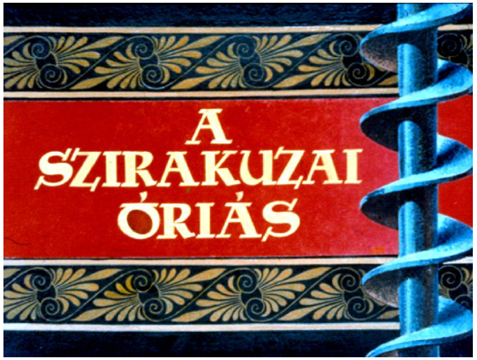
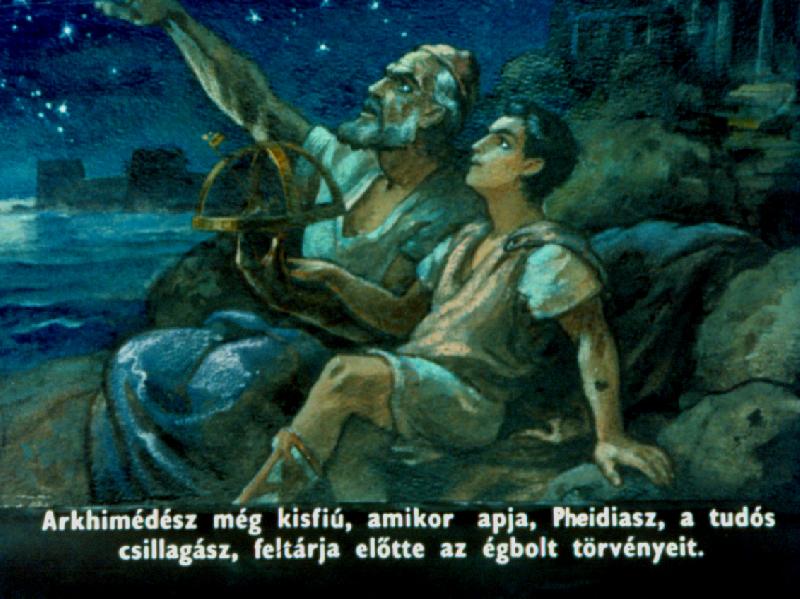
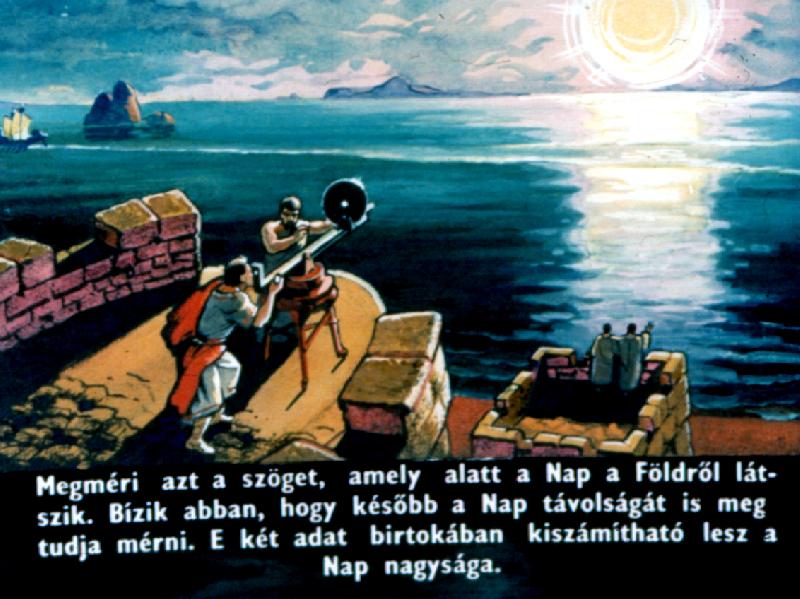
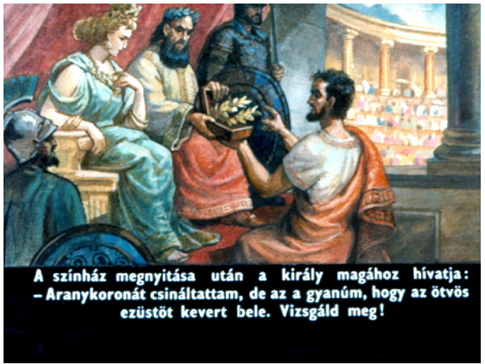
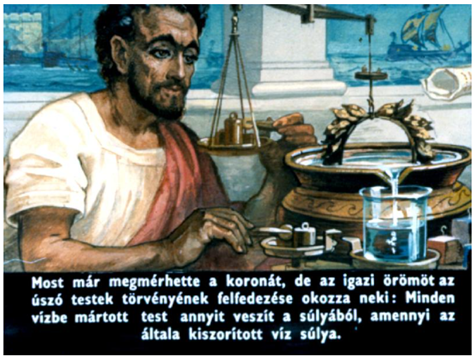
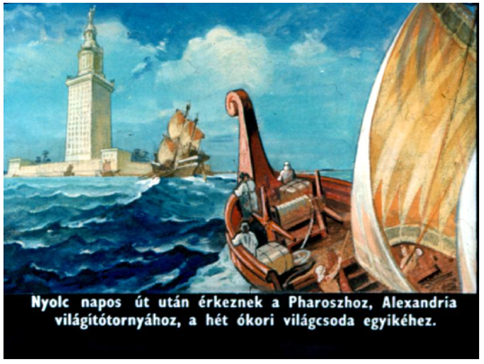
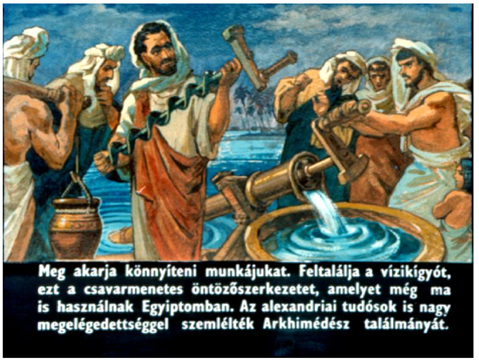
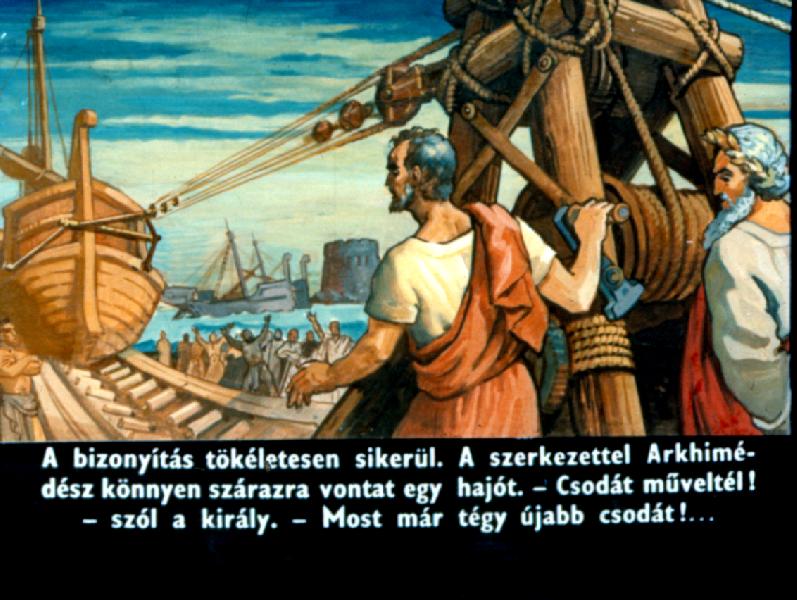
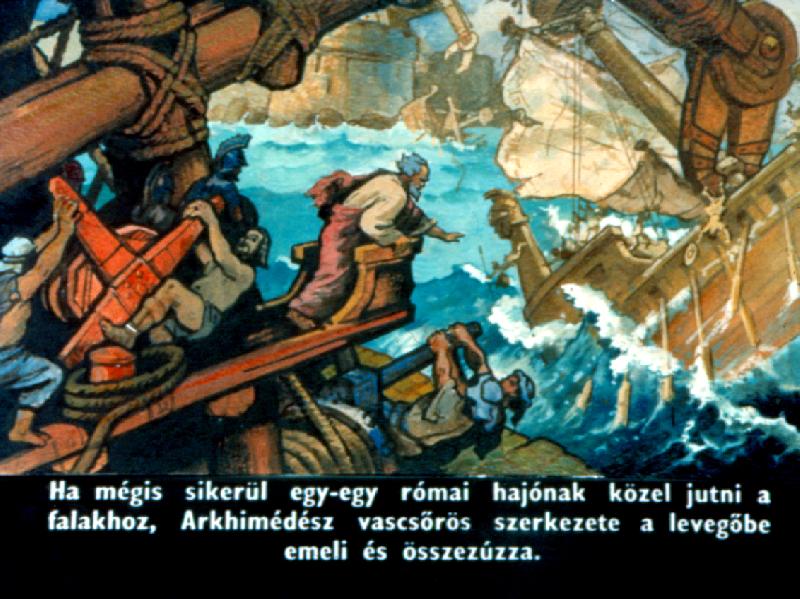
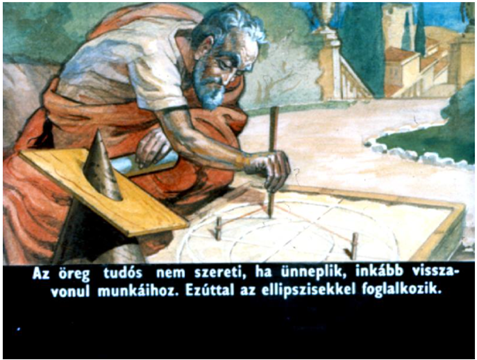
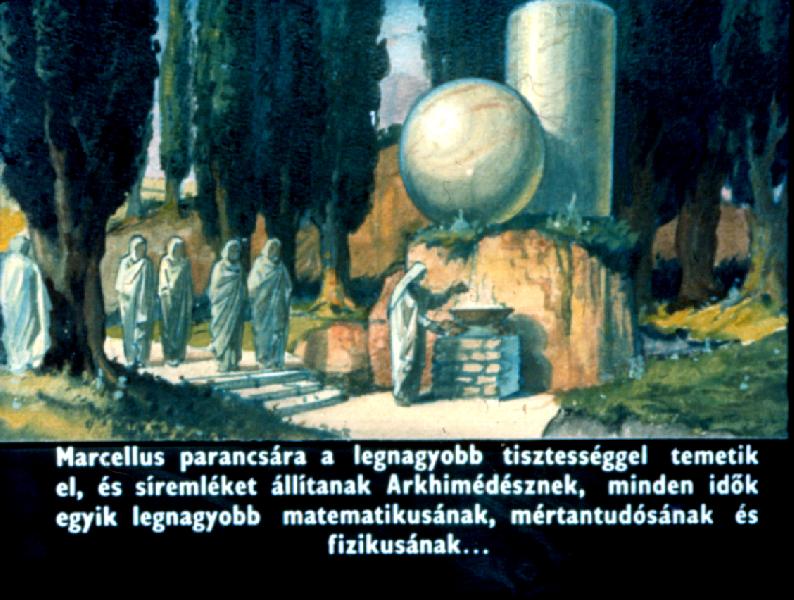
Selected pictures from the Hungarian slideshow for children based on the novel.
Source: OSA Archivum under Creative Commons Licence 
The slides from the slideshow are available on the Diafilm channel on YouTube (accessed: June 17, 2022).


